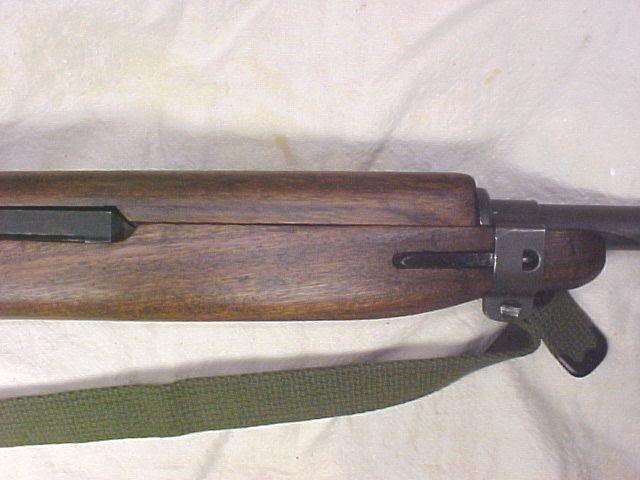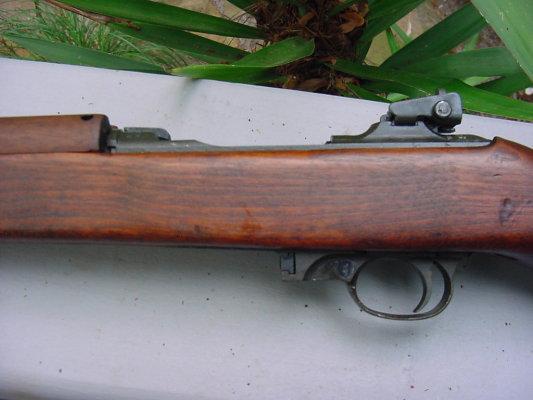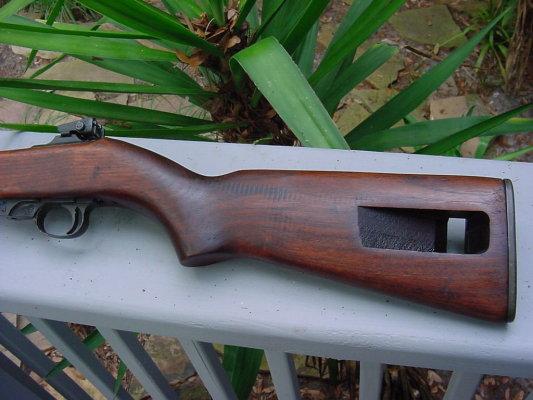-
Legacy Member

While the US military initially used linseed oil to finish stocks & handguards, at some point they changed to tung oil. The stock pictured is a WW2 replacement stock that I stripped & refinished with 3 coats of tung oil, rubbing with 0000 steel wool after each coat. The steel wool cuts the gloss & gives a matte finish.
to finish stocks & handguards, at some point they changed to tung oil. The stock pictured is a WW2 replacement stock that I stripped & refinished with 3 coats of tung oil, rubbing with 0000 steel wool after each coat. The steel wool cuts the gloss & gives a matte finish.

-
-
11-12-2012 06:55 PM
# ADS
Friends and Sponsors

-
Legacy Member

The "hard shinny" finish is why we don't use BLO . RLO leaves a dull finish that is not hard or slick when wet. Once BLO
. RLO leaves a dull finish that is not hard or slick when wet. Once BLO is on a stock, you can not put RLO on it. To me, a stock with BLO is ruined as a collector stock. As a shooter, BLO protects the wood better than RLO.
is on a stock, you can not put RLO on it. To me, a stock with BLO is ruined as a collector stock. As a shooter, BLO protects the wood better than RLO.
-
-
Legacy Member

The stock has the same finish as when I got it. It was NOT a RLO finish, as it was already hard and shiny. The Inland is all original as left the factory, with 95% finish metal, and the stock appears to be original to the weapon. I have no idea of when it acquired its current finish, and could really care less. I have had stocks with the RLO finish, and I know what they are like (like the CMP Inland I had). I did not strip it, but rather cleaned it with a wipe down of 50/50 mix. Whatever "collector value" may have been ruined, was already done before I got it.... In my mind, stripping the finish to re-finish it with BLO
Inland I had). I did not strip it, but rather cleaned it with a wipe down of 50/50 mix. Whatever "collector value" may have been ruined, was already done before I got it.... In my mind, stripping the finish to re-finish it with BLO takes away from its originality as I received it.
takes away from its originality as I received it.
-
-
FREE MEMBER
NO Posting or PM's Allowed

The stock finish doesn't have to be the same as the military contractors used, as you can't apply it the same way they did. If you want the stock to appear original, what you are trying to do is duplicate the appearance of finish that was originally applied. So far the 50/50 BLO /Turpentine does that better than anything I have found. The original military finish was not a built up finish, and original stocks show open grain.
/Turpentine does that better than anything I have found. The original military finish was not a built up finish, and original stocks show open grain.
This is the right side of any original 5.4 million Inland showing the acceptance mark. You can see the open grain in the photo.

-
Legacy Member

Ima,
I understand you cleaned up a well used stock and put BLO on it. I understand it could have had BLO
on it. I understand it could have had BLO before. If I remember right, you asked what to use. I replied and the last post explains why I responded as I did. I said BLO does treat a stock better. It is just not right for a carbine.
before. If I remember right, you asked what to use. I replied and the last post explains why I responded as I did. I said BLO does treat a stock better. It is just not right for a carbine.
As a funny note, I bought one of those "white bag" 6.4 Winchester carbines from 2003. It was not cheap, don't you know. Those stocks were very dry from storage since 1955 and many were collector grade. When I received carbine, the stock was freshly oiled but did not feel, smell right. I knew it was not BLO but not right for RLO either. I asked the seller what he used, and he proudly said, "Syntec". I wanted to puke. Since then, every chance I have, I try to promote the use of RLO on carbine stocks. For every one person who posts, there are a hundred reading and many of those doing.
I do not want to think of how many collector grade stock have had BLO put on them since 2003. I have been there, thinking you were doing right but really doing wrong. There is no way I will throw a stone.
-
Thank You to Bubba-7 For This Useful Post:
-
FREE MEMBER
NO Posting or PM's Allowed

Maybe some have found a way to use RLO. bit most people using RLO will end up with a sticky mess. The BLO /Turpentine exactly duplicates the appearance of the original finish, and dries overnight. There is no one correct way to do it, and the best way is the one that works for each individual.
/Turpentine exactly duplicates the appearance of the original finish, and dries overnight. There is no one correct way to do it, and the best way is the one that works for each individual.
-
Legacy Member



The hard finish from BLO is not right. It may look right and GI but not on a carbine. In using RLO put it on wait a few minutes and rub it off. The fresh oil will soften the old oil some and you will rub off dirt. It is almost like rubbing off all you put on. It is not easy as painting on a thick coat and let it dry.
is not right. It may look right and GI but not on a carbine. In using RLO put it on wait a few minutes and rub it off. The fresh oil will soften the old oil some and you will rub off dirt. It is almost like rubbing off all you put on. It is not easy as painting on a thick coat and let it dry.
It is work. I use both a 50/50 mix for soaking in when needed to 100% RLO. Rub it on heavy, and as much time as you like, one minute to an hour or two. Them rub it off, hard. Any area where the finish has gotten thin, the RLO will soak in. In other areas it all will rub off and take some dirt with it. After you rub it down, put the metal back in. You are done.
You will be left with a fresh oiled stock with open pores and a soft feel that your hand can sense. RLO does not dry. It either soaks in and is gone or you rub it off and it's gone. You are left with wood as the surface finish and not a shinny coat of whatever dried oil as the surface finish.
This is the best explanation as I can do. I have ruined stocks with Tru-oil, tung oil, BLO . They may look good and/or I was happy with them after I did them, but now, it saddens me to see them. All that work just to ruin a stock. Please gentlemen, no more.
. They may look good and/or I was happy with them after I did them, but now, it saddens me to see them. All that work just to ruin a stock. Please gentlemen, no more.
Last edited by Bubba-7; 11-13-2012 at 07:38 PM.
-
to finish stocks & handguards, at some point they changed to tung oil. The stock pictured is a WW2 replacement stock that I stripped & refinished with 3 coats of tung oil, rubbing with 0000 steel wool after each coat. The steel wool cuts the gloss & gives a matte finish.















 PM
PM










